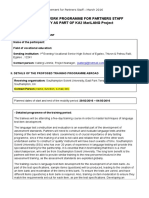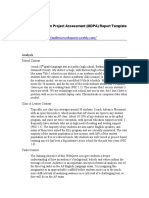Community Service Learning Using Ed. Podcasts
Community Service Learning Using Ed. Podcasts
Uploaded by
n_wildesCopyright:
Available Formats
Community Service Learning Using Ed. Podcasts
Community Service Learning Using Ed. Podcasts
Uploaded by
n_wildesOriginal Description:
Original Title
Copyright
Available Formats
Share this document
Did you find this document useful?
Is this content inappropriate?
Copyright:
Available Formats
Community Service Learning Using Ed. Podcasts
Community Service Learning Using Ed. Podcasts
Uploaded by
n_wildesCopyright:
Available Formats
Nathaniel Wildes Community Service Learning Using Ed.
Podcasts Project focus: Supporting Technology Project Description: I will draft up a grant proposal for an Educational Podcast project, which will address the drop out rates and below average proficiency scores in the San Bernardino school district. This proposal will speak to these proficiency scores and outline the goals that the inherent program will attempt to achieve. At the core of the proposed project is a series of best practices Podcasts that will be developed using our resources at CSUSB and then be distributed to educational leaders within the region. The purpose of this project is to provide professional development tools to those that are in a disposition to utilize this type of technology as an educational tool and refine their educational approach to better support their students needs. As a result, we hope that these educators will become more confident in their roles and in turn their improved instruction will lead to an increase in their students academic achievement. The proposal will include an executive summary, a timeline, a list of goals, the means of measuring the projects effectiveness and an itemized budget. I chose this project because I work part time with the Literacy Center on campus and we know that we could have a huge impact if we could only make the type of instruction and resources that we have available accessible to those who need it most. I think that if this project were ever to materialize, we could become a primary resource center for this type of professional development within the San Bernardino school district. Nonetheless, developing a proposal like this is great practical experience and will familiarize me with the process, preparing me for potential funding opportunities in the future. Project Artifacts: Executive summary List of goals Project timeline Itemized budget Program evaluation plan Completed grant proposal
Project Timeline: Start Date- 10/4/11
Milestone 1- Draw up an outline identifying resources and all parties involved in the proposed project Milestone 2- Identify and research the tools/resources that will be necessary to complete the proposed project as well as the cost Milestone 3- Create an executive summary Milestone 4- Create a timeline describing in detail the goals and intentions of the proposed project Mile stone 4- Create a program evaluation plan Finish Date- 12/1/11
ARTIFACTS: Executive Summary
Dropping out of high school is generally the final act in a series of events that have taken place across time and that has serious economic implications for years to come. Once such factor is continued academic failure. In San Bernardino City Unified School District, 72% of the students in grades 2-10 are scoring below proficient in the area of language arts and 73% scoring below proficient in mathematics (CDE, 2008). The San Bernardino County Creative After School Programs for Success (CAPS) works with 6700 students at 32 school sites with before and after-school experiences that enhance students academic, social and emotional development. The CAPS program will soon expand to include high schools. CSUSB undergraduate students are hired as CAPS Leaders to provide homework assistance and enrichment activities at the school sites. CAPS leaders are provided little training beyond the program orientation and on-site guidance from CAPS teachers. The Ed Podcast Project will create literacy education training podcasts for the CAPS leaders. Podcasting is a powerful publishing platform that addresses different learning styles, is highly mobile, and can stimulate creative thinking. Lessons will be researched and designed by CSUSB graduate students through a series of new service learning courses in the Graduate Reading Program (ERDG). Staff at CSUSBs Watson & Associates Literacy Center will assist with the technical production, and each podcast will be evaluated for content and delivery. Content of the podcasts will be adjusted to meet the needs of elementary, middle school and high school students. Program goals include increasing the student participants reading skills by at least one proficiency level.
Goals
The major goals of the Ed Pod Program are as follows: 1) to increase the academic achievement levels of K-12 students in English Language Arts by one
proficiency level (advanced, proficient, basic, below basic & far below basic), 2) to create better prepared CAPS Leaders and other community-based educators who are confident they are providing students with high quality before and after-school literacy learning experiences, 3) to promote changes in the use of educational technology and pedagogical content knowledge in language arts, and 4) to develop high quality, research-based podcasts for distribution to a wider educational audience. To meet these goals, the Watson and Associates Literacy Center will develop and house a series of research-based educational podcasts covering relevant topics in the area of English Language Arts assessment and instruction. Additionally the content of the podcasts will be evaluated on an individual basis by the CAPS Leaders and will be modified until they receive the minimum of an above average rating on the podcast evaluation rubric. The refinement of the podcasts will be continual in order to provide the participants with an exemplary tool for ongoing professional development thus leading to an improvement in the students academic achievement in language arts. It is also our belief that by improving the quality of education and support the CAPS Leaders receive, they will be more likely to make a longer term commitment to the CAPS program, will become more confident in their use of technology as an educational tool and may even be more likely to pursue a career in education. Overall, this can be a win-win situation for all involved.
Timeline
Development and Implementation Activity
1. Purchase the technology for the development of the ed podcasts. 2. Provide training on the technology for major grant participants at CSUSB and the participating school sites. 3. Develop new service learning courses 4. Conduct a needs assessment of the instructors in the CAPS program at the elementary, middle and high school levels at the three pilot schools in SB 5. Prepare needs assessment analysis document to be used to develop the initial three podcasts for each pilot school site. 6. Develop and maintain a database to maintain all assessment results from each school site. 7. Refine the program and school site assessment systems to be implemented across the three year time period. 8. Expand Literacy Center website to enable it to host the ed podcasts for use with community partners. 9. Conduct research on best practices in the following areas of language arts to be used when developing the podcasts: a) decoding, b) comprehension, c) writing various genres, d) writing conventions, e) spelling, f) oral language development, g) English language development for ELLs, and i) literacy
Year 1 X X X X X X X X X
Year 2
Year 3
X X
X X
assessment across language arts. 10. Develop three research-based podcasts for all of the participating school sites that address the needs identified by the needs assessment surveys/interviews. Develop and utilize a post-podcast evaluation form for use with all participating CAPS instructors. 11. Provide professional development on the use of ed podcast technology for school-site CAPS instructors. 12. Conduct an end of the year evaluation of the effectiveness of the podcasts by CAPS instructors.
X X
X X
X X
Itemized Budget (equipment only/no salaries) Microphone for voiceovers: $300 Wireless lavalier microphones:.$450 Audio mixer station.$400 Laptop computer...$1,500 Recording software.$600 Web server/domain.$150 (for 3 years) _______________________________________________________________________ Total Equipment Cost $3,400 Program Evaluation Plan
The Ed Podcast Program Evaluation Plan will consist of a series of formative and summative assessments that take place across the 3-year grant development and implementation time period. To begin with a mixed design needs assessment will be developed to accurately assess the strengths and needs of the present CAPS instructional program. CAPS Leaders, CAPS Teachers and the Director of the CAPS Program for the SBCUSD will participate in this survey and interview process. Based on the findings, the podcasts will be developed and made accessible to the participating educators. Embedded within the podcast website will be a postviewing evaluation rubric. Participants will be asked to provide continuing feedback as they progress through the professional development program so modifications can be made immediately. At the end of each school year, all participants will be contacted and asked to provide a final evaluation of the Ed Podcast Program as well. Researchers will also be collecting demographic information on the retention rate/time CAPS Leaders remain with the CAPS program, the Leaders academic major in college and note any changes in their perceptions of their ability to provide high quality literacy instruction to the CAPS students. A second layer of the evaluation plan relates to the academic achievement of the K-12 students in the area of English language arts. Access will be gained to the
overall school and district achievement test scores as well as to the individual test scores of the participants. Researchers will review the annual Content Standards Test scores (CSTs) as well as the district benchmark scores, state high school exit exam scores (CAHSEE), and English language development scores for ELLs (CELDT). Together these assessments will provide a window into the impacts of the podcasts on the English language arts achievement levels of participating students to determine if they have increased their overall proficiency levels. Program Sustainability Plan: The sustainability of the Ed Podcast Program is based on the fact that the Literacy Center has been in place at the university for over seven years. The faculty and staff are experienced with the various technologies and have the content area expertise to develop high quality professional development podcasts. Additionally the university has a well established record of providing students with service learning courses to enhance their learning experiences. Because the CAPS program has been an integral part of the SBCUSD for 14 years, it has solid roots in the educational community thus allowing us to build on its current structure. Within the College of Education, the Dean is highly supportive of this new collaboration and will work with the Literacy Center to promote this project.
Rationale
San Bernardino City Unified School District (SBCUSD) is in the Inland Empire, 70 miles east of Los Angeles. SBCUSD is the sixth largest district in California and has a K-12 enrollment of over 42,000 students. Of its 65 schools, 68.2% are in Program Improvement. 79.5% of students qualify for free and reduced lunch through the National School Lunch Program (NSLP). 20% of SBCUSDs children live below the poverty level (Annie D. Casey Foundation). Additionally over 33% of the Districts student population are classified as English Language Learners (ELL). As in many of the urban school districts in the State, SBCUSD has demonstrated an achievement gap between ELLs and their White counterparts while in total, the all subgroups of students in SBCUSD are scoring well below the state average in mathematics and language arts at the elementary level. Table 1.0 provides a comparison of district and state proficiency scores for students in grades 2-10. Table 1.0: Districts Achievement Gap as Compared to California State-Wide Data District versus State Data Percentage of students Percentage of students who are below proficient who are below proficient in language arts in mathematics SBCUSD 72% 73% State of California 54% 57% The rationale for developing a university-based professional development program that connects the San Bernardino City Schools Creative After School Programs for Success (CAPS) with the Watson and Associates Literacy Center on the
CSU, San Bernardino campus is based on a high need for high quality after school academic support for K-12 students in our local community. SBCUSD has provided before and after school assistance to its students since 1998. Many of the CAPS instructors are also undergraduate students at the university who may or may not have a background in literacy instruction. In an attempt to provide instructional support to the CAPS teachers, the university will offer a research-based professional development program that is based on needs identified by the CAPS teachers. To do so the Literacy Center will develop a series of educational podcasts that the CAPS teachers will be able to access at home, at their job sites or on campus by logging onto the centers website. Literature on professional development states that when training is made convenient for those intended to participate, participation can be increased. When planning for students who work full time, attend school full time or have full time family commitments, often choosing between those commitments and attending training becomes an issue. Using the technologies of podcasts and website access, effective training can be offered to a broader and specific audience. The Literacy Center opened its doors in the fall of 2004, providing one-on-one literacy tutoring (covering the areas of reading, writing, spelling, and oral language development) to children in grades K-12 four afternoons per week. The tutoring sessions are one hour in length and run for 8 weeks during the fall, winter and spring quarters. During the first year of service (2004-2005), the center served approximately eight children per day for a total of 32 children per week. Across time, more tutors volunteered their services to the center, which allowed us to expand our services and open 15 tutoring slots per day/ four days per week. At present, the center has doubled its tutoring capacity and now serves approximately75 students per quarter. While many of the children return to the center for a minimum of three quarters, we have successfully exited approximately 20% of our students.
You might also like
- Marilang Mobility Agreement Staff 1st Training v2Document13 pagesMarilang Mobility Agreement Staff 1st Training v2api-297330260No ratings yet
- Analysis of An Annual Teaching Plan: EOI Santa Coloma de Gramanet L5Document13 pagesAnalysis of An Annual Teaching Plan: EOI Santa Coloma de Gramanet L5Irma Rodriguez QuintanaNo ratings yet
- Volcanoes Explanation Texts UnitDocument10 pagesVolcanoes Explanation Texts UnitHendarwin Darwin0% (1)
- Course Syllabus tcbp2017Document5 pagesCourse Syllabus tcbp2017api-247846409No ratings yet
- Prospectus For Principal - TempDocument19 pagesProspectus For Principal - Tempapi-275139555No ratings yet
- Standards-Based Learning Funds Proposal: Putting Technology Into The Hands of Second Grade WritersDocument2 pagesStandards-Based Learning Funds Proposal: Putting Technology Into The Hands of Second Grade Writersapi-93982841No ratings yet
- Geps School Plan 2013Document15 pagesGeps School Plan 2013api-250444032No ratings yet
- Williams-N-Mdp-Projectreport v2Document9 pagesWilliams-N-Mdp-Projectreport v2api-259409323No ratings yet
- Edld 6360 Sec. 793 - School Finance Spring 2014: William Allan Kritsonis, PHDDocument14 pagesEdld 6360 Sec. 793 - School Finance Spring 2014: William Allan Kritsonis, PHDAnonymous aDHOj5No ratings yet
- Form 2 PPA 1 2Document31 pagesForm 2 PPA 1 2Espinosa Teves Fernan100% (2)
- Sample Curricula Bachelor of Secondary EducationDocument28 pagesSample Curricula Bachelor of Secondary Educationjosefalarka100% (1)
- FinalwalkerjobembeddedprojectDocument21 pagesFinalwalkerjobembeddedprojectapi-256202367100% (1)
- District Strategic Plan 2021Document64 pagesDistrict Strategic Plan 2021Referencista BibliotecaNo ratings yet
- Faculty Growth Plan Maxwell 2013-14-2Document2 pagesFaculty Growth Plan Maxwell 2013-14-2api-222054654No ratings yet
- Multimedia Design Project Mdpa Itec 7445Document6 pagesMultimedia Design Project Mdpa Itec 7445api-256960065No ratings yet
- Beijing Study Tour Abed Year 4 Acp - Report 2015Document4 pagesBeijing Study Tour Abed Year 4 Acp - Report 2015api-296671363No ratings yet
- Sector Teacher Training Grant FINALDocument15 pagesSector Teacher Training Grant FINALAnjali PradhanNo ratings yet
- Phe Title Iia Proposal FinalDocument19 pagesPhe Title Iia Proposal Finalapi-321107718No ratings yet
- Parcc Overview September2013 3Document25 pagesParcc Overview September2013 3api-261529741No ratings yet
- Grant Application NarrativeDocument3 pagesGrant Application Narrativeapi-241005093No ratings yet
- Curriculum VitaeDocument16 pagesCurriculum Vitaechavez.fds4uNo ratings yet
- Spring 2024 Edu 412 Literacy Development SyllabusDocument12 pagesSpring 2024 Edu 412 Literacy Development Syllabusapi-666836611No ratings yet
- Faculty Growth Plan Maxwell 2014-15Document2 pagesFaculty Growth Plan Maxwell 2014-15api-222054654No ratings yet
- LRC Sampleapp GwuDocument51 pagesLRC Sampleapp GwuJeremiah MasambaNo ratings yet
- Bwalsh MDP Projectreporttemplate 3Document7 pagesBwalsh MDP Projectreporttemplate 3api-509386272No ratings yet
- Educ 5324-Technology PlanDocument9 pagesEduc 5324-Technology Planapi-302421105No ratings yet
- Close-Up On Career Planning: A Key Strategy For Advancing The NLC VisionDocument27 pagesClose-Up On Career Planning: A Key Strategy For Advancing The NLC VisionJitendra PatelNo ratings yet
- Form 2 SignedDocument16 pagesForm 2 Signedapi-375486384No ratings yet
- Sip Analysis and DiscussionDocument5 pagesSip Analysis and Discussionapi-290871487No ratings yet
- Sample SeniorcapstoneproductproposalformDocument2 pagesSample Seniorcapstoneproductproposalformapi-325611859No ratings yet
- Grant 1Document2 pagesGrant 1api-746022678No ratings yet
- It Grant Applicationjburnsitec7410Document6 pagesIt Grant Applicationjburnsitec7410api-370169875No ratings yet
- English I Curriculum GuideDocument41 pagesEnglish I Curriculum Guideapi-325614013No ratings yet
- 0311 CG2 EnglishDocument115 pages0311 CG2 EnglishstellmendzNo ratings yet
- EES 5 Detail 3Document20 pagesEES 5 Detail 3York Daily Record/Sunday NewsNo ratings yet
- PHD Thesis Curriculum DevelopmentDocument4 pagesPHD Thesis Curriculum Developmenttygocixff100% (1)
- 7 The Dition Standards and IndicatorsDocument25 pages7 The Dition Standards and IndicatorslionelremediosNo ratings yet
- General Terms and Conditions "Becas Santander Languages - English For Professional Development - University of Pennsylvania " PROGRAM 2020/2021Document5 pagesGeneral Terms and Conditions "Becas Santander Languages - English For Professional Development - University of Pennsylvania " PROGRAM 2020/2021BRUNO ANTONIO GALLARDONo ratings yet
- ENGLISH I Secondary Education Curriculum 2010Document39 pagesENGLISH I Secondary Education Curriculum 2010Ludger KresnikNo ratings yet
- Bigcreekes 1314 FinalDocument13 pagesBigcreekes 1314 Finalbookee123No ratings yet
- CONCEPT PAPER Special Project DevelopmenDocument3 pagesCONCEPT PAPER Special Project DevelopmenJomar MacapagalNo ratings yet
- Diagnostic Academic English Language TestDocument4 pagesDiagnostic Academic English Language TestZulfiqar AhmadNo ratings yet
- Portfolio Artifacts: Required Artifacts Possible Additional ArtifactsDocument4 pagesPortfolio Artifacts: Required Artifacts Possible Additional ArtifactssherrymiNo ratings yet
- EDS 4643 Methods of Teaching Social StudiesDocument5 pagesEDS 4643 Methods of Teaching Social Studiesmohammedhafiz2046No ratings yet
- Alberta Initiative For School Improvement (AISI) Project SynopsisDocument27 pagesAlberta Initiative For School Improvement (AISI) Project SynopsisJhemson ELisNo ratings yet
- Title of Project: Persuasive Media Project Subject(s) : Junior Honors Language Arts/American Literature Grade Level(s) : 11 AbstractDocument9 pagesTitle of Project: Persuasive Media Project Subject(s) : Junior Honors Language Arts/American Literature Grade Level(s) : 11 Abstractapi-404220964No ratings yet
- Syllabus-Spring2015 EDU 680 3/15Document14 pagesSyllabus-Spring2015 EDU 680 3/15kstone5No ratings yet
- Group 3 SciEd205 Cur DevDocument37 pagesGroup 3 SciEd205 Cur DevDafodellePaghasianNo ratings yet
- Program InstructionDocument22 pagesProgram Instructionmelinda santosNo ratings yet
- ICS2ODocument7 pagesICS2OAdam MikitzelNo ratings yet
- LBSC 741Document16 pagesLBSC 741shmst13No ratings yet
- Dnhy 490s Dental Hygiene Capstone Service Learning Project MonographDocument20 pagesDnhy 490s Dental Hygiene Capstone Service Learning Project Monographapi-315590389No ratings yet
- Sed 478 f16 SyllabusDocument31 pagesSed 478 f16 Syllabusapi-307522519No ratings yet
- Ecis Mag - Article On MypDocument2 pagesEcis Mag - Article On Mypapi-281870579No ratings yet
- Faculty JobDocument7 pagesFaculty JobGabrielle BimpsonNo ratings yet
- Medt7487 Portfolio Matrix ThyDocument5 pagesMedt7487 Portfolio Matrix Thyapi-249538246No ratings yet
- HND Creative Media HandbookDocument8 pagesHND Creative Media HandbookbrettmaxNo ratings yet
- k-12 Guidelines-1Document26 pagesk-12 Guidelines-1api-639902794No ratings yet
- From the Classroom to the Test: How to Improve Student Achievement on the Summative ELA AssessmentsFrom EverandFrom the Classroom to the Test: How to Improve Student Achievement on the Summative ELA AssessmentsNo ratings yet
- Evaluating Your College's Commitment to the Recruitment & Retention of Students of color: Self-Evaluation InstrumentFrom EverandEvaluating Your College's Commitment to the Recruitment & Retention of Students of color: Self-Evaluation InstrumentNo ratings yet
- Introduction to VRS Interpreting: A Curriculum GuideFrom EverandIntroduction to VRS Interpreting: A Curriculum GuideNo ratings yet
- Portfolio ResponseDocument2 pagesPortfolio Responsen_wildesNo ratings yet
- Username: Etec Password: Etec: Student Access To CourseDocument17 pagesUsername: Etec Password: Etec: Student Access To Coursen_wildesNo ratings yet
- Project 1Document8 pagesProject 1n_wildesNo ratings yet
- MultimediaDocument2 pagesMultimedian_wildesNo ratings yet
- Sampling GuideDocument1 pageSampling Guiden_wildesNo ratings yet
- Digital Music Prod. RubricsDocument4 pagesDigital Music Prod. Rubricsn_wildesNo ratings yet
- ETEC Week6Document5 pagesETEC Week6n_wildesNo ratings yet
- SyllabusDocument6 pagesSyllabusn_wildesNo ratings yet
- Report of Proceeding-CdioDocument2 pagesReport of Proceeding-Cdionoli90No ratings yet
- Janae Sayler: The Pennsylvania State University - University Park, Servstate - UniversityDocument1 pageJanae Sayler: The Pennsylvania State University - University Park, Servstate - Universityapi-508414953No ratings yet
- 131RGApplication PDFDocument2 pages131RGApplication PDFMuhammad FarhanNo ratings yet
- Kazim Usman-Teaching PDFDocument2 pagesKazim Usman-Teaching PDFSyed Kazim AliNo ratings yet
- English Writing Exercises For B1 - A Narrative - English Practice OnlineDocument1 pageEnglish Writing Exercises For B1 - A Narrative - English Practice Onlinevero 2No ratings yet
- Project Monitoring Report Form (Year 2) : MED Everyday Mathematics Enhancers and Drills)Document2 pagesProject Monitoring Report Form (Year 2) : MED Everyday Mathematics Enhancers and Drills)Danilo Siquig Jr.No ratings yet
- #12 Estimating Sum of The NumbersDocument20 pages#12 Estimating Sum of The NumbersWILFRED BAGSAONo ratings yet
- Advertisement DDMADocument8 pagesAdvertisement DDMApunNo ratings yet
- 16 Steps For Discovery and Empowerment: Through The Voices of Many Women and MenDocument1 page16 Steps For Discovery and Empowerment: Through The Voices of Many Women and MenMaximiliano xDNo ratings yet
- Evolution Des Religions Africaines Aux Contacts Des Religions Et Societes Occidentals Du ZambeziDocument330 pagesEvolution Des Religions Africaines Aux Contacts Des Religions Et Societes Occidentals Du ZambeziRené yvesNo ratings yet
- B2 First - 2024 Useful LinksDocument3 pagesB2 First - 2024 Useful LinksPatrícia FariaNo ratings yet
- Buku EspDocument123 pagesBuku EspLena Marliana HarahapNo ratings yet
- Eng 6-Cot-Q4Document5 pagesEng 6-Cot-Q4MARICEL CLADO100% (1)
- Business Law Course Outline Lecture 2014Document7 pagesBusiness Law Course Outline Lecture 2014Zwelithini MtsamaiNo ratings yet
- Grade 11 Book ListDocument3 pagesGrade 11 Book ListSarvajith PedapatiNo ratings yet
- Action Research Project: Noemi Waight & George Reese MsteDocument9 pagesAction Research Project: Noemi Waight & George Reese MsteMrigendra MishraNo ratings yet
- Thesis ProposalDocument2 pagesThesis ProposalshamrockthedoorNo ratings yet
- Academic Stress Among University Students and Its Effect On Mental HealthDocument163 pagesAcademic Stress Among University Students and Its Effect On Mental HealthAniceto Secang SardoNo ratings yet
- BSC in Public SectorDocument13 pagesBSC in Public SectorpeksiNo ratings yet
- Reading I - The Nature and Attraction of MootingDocument18 pagesReading I - The Nature and Attraction of MootingAzambhatiNo ratings yet
- Electrical Power and Ilumination SystemsDocument320 pagesElectrical Power and Ilumination SystemsChristian MarquezNo ratings yet
- The Effect of Transformational Leadership and Organizational Culture On Performance of Lecture Through Innovative Work Behavior at Catholic Universites in SurabayaDocument11 pagesThe Effect of Transformational Leadership and Organizational Culture On Performance of Lecture Through Innovative Work Behavior at Catholic Universites in SurabayaBernardus Aris FerdinanNo ratings yet
- Unit 3 Development of Personality and Assessment: StructureDocument21 pagesUnit 3 Development of Personality and Assessment: StructureSharmila SubramanianNo ratings yet
- The Wechsler Intelligence ScalesDocument42 pagesThe Wechsler Intelligence ScalesChris CeNo ratings yet
- CensorshipDocument32 pagesCensorshipElmer CrisostomoNo ratings yet
- H.L.A. Hart & The Noble DreamDocument30 pagesH.L.A. Hart & The Noble DreamFuckernanNo ratings yet
- Secondary Student'S Permanent RecordDocument60 pagesSecondary Student'S Permanent RecordFred Ryan Canoy DeañoNo ratings yet
- Coursera NXY2VTRPPRW4 PDFDocument1 pageCoursera NXY2VTRPPRW4 PDFKreepa Chowrasia ABS, NoidaNo ratings yet
- Call For Editor: Indigenous StudiesDocument2 pagesCall For Editor: Indigenous Studiesapi-86832247No ratings yet

































































































